Most people don’t love sand. They tolerate it in context, lounging on a towel by the seaside or scooping it around with their youngsters on the playground.
But most people — normal people — don’t run around to every beach or desert scooping sand into little sample bottles, peering at it with a magnifying glass, and rhapsodizing about variations in color and texture.
They don’t love sand for sand’s sake. Unless, like me, they’re an arenophile.
The Green Sands of Papakōlea
My obsession started on Papakōlea.
I spent the morning trekking along the windswept southern coastline of Hawaii, just a few miles away from the southernmost point of the United States. The worn, unmarked footpath snaked through the low coastal grass, cut across in places by a maze of 4×4 tracks.
After a few kilometers the cliff face fell away to reveal a small beach, tucked into a shallow bowl between the cliffs, where the sand glittered green like fool’s gold in the tropical sun. Created by an accident of geology, these olivine sands are one of only four green sand beaches in the entire world.
And I’ve never looked at sand the same way since.
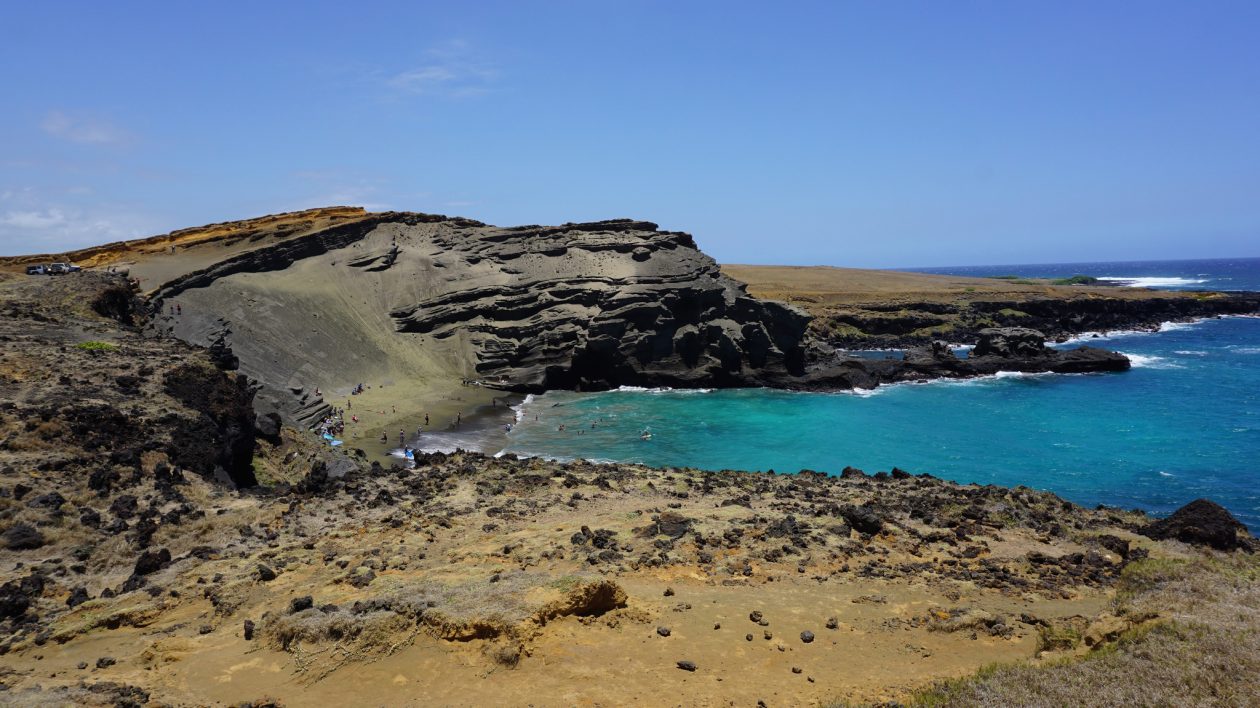
The memory of that green sand stayed with me long after leaving Hawaii, and in the years since my curiosity has morphed into a mild obsession. I’ve been a dedicated birder for nearly a decade, so I suppose it was only a matter of time before I found an even stranger hobby.
With each beach or desert or lake shore I visited, I started to notice that plain old sand was anything but plain. Some are coarse and gritty, with small pieces of visible shells, others fine and smooth like flour. Some sands shimmer with traces of silicates. Their colors defy description: rust red sands of the Australian deserts, jet black from Iceland and Hawaii, grey, blue, green, and every shade imaginable in between white and cream.
I was hooked.
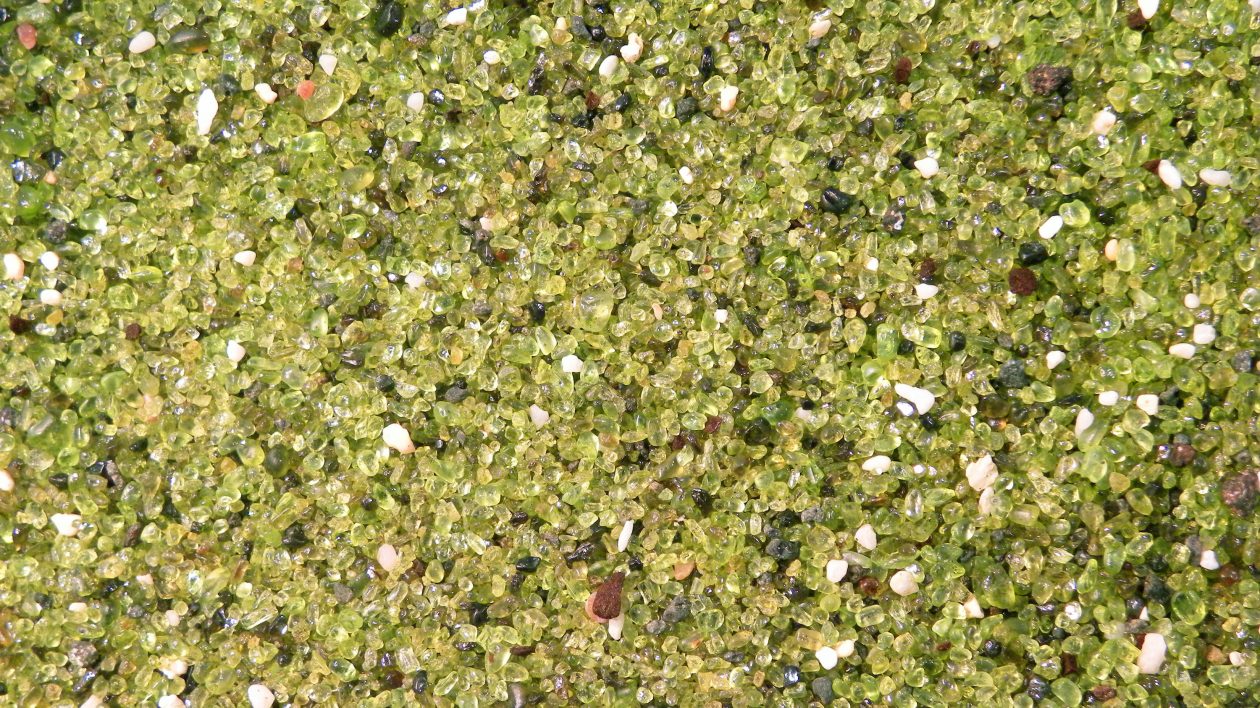
As with all obsessions, my early days were marked by secret shame. I felt horribly conspicuous when I first learned how to bird, the binoculars around my neck practically screaming “weirdo” to the rest of the world.
It was much the same way with sand. At the beach I would furtively shovel handfuls of it into ziplock bags, hoping the beachgoers asleep in the sun a full 20 meters away wouldn’t notice. Hiking across a riverbank, I’d wait until the trail was empty before nonchalantly bending down — still pretending to tie my shoe even though the coast was clear — and scoop sand into a spare water bottle.
Thankfully, as with birding, it didn’t take long for my absurd self-consciousness to dissipate. I’m already the giant nerd with the binoculars and the field guide, so no one is going to notice if I’m also wielding a baggie of sand.
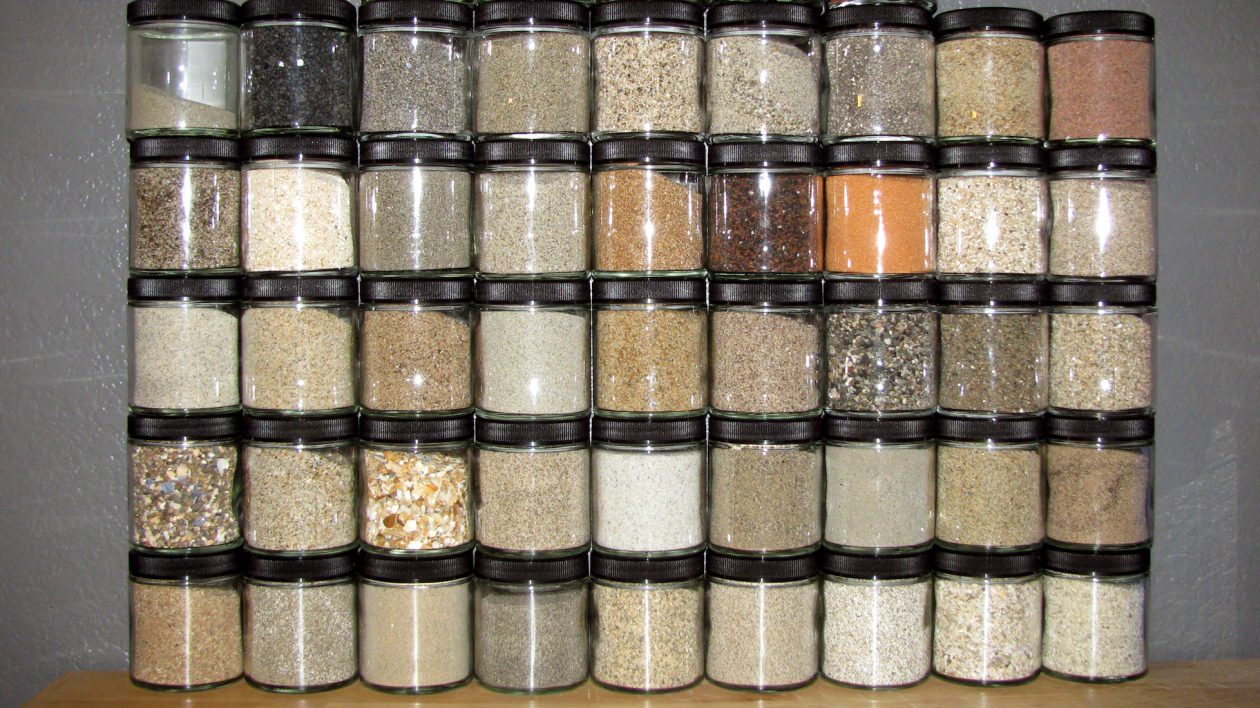
The Sand Nerd Brigade
Incredible as it may seem, I am not the only arenophile on Earth. Early on I plugged “sand collecting” into Google and found the website of the International Sand Collectors Society, whose members seek to “discover the world, grain by grain.” Incredibly, their droll tagline is bested by the title of their newsletter — “The Sand Paper” — which wins my unofficial award for worst pun of the century.
I discovered a whole community of substrate nerds who are apparently far more on their game than I am… tracking their samples in detailed Excel databases and actively trading sand samples with other enthusiasts. Some build their own custom storage and display drawers, while others specialize in macro photography of each sample.
It was here that I learned that “sand” is actually a technical, geological term for granular material that is finer than gravel and coarser than silt. Exact specification vary by country, but many geologists consider sand grains to be sized between 0.0625 mm to 2 mm. Anything smaller is silt, which feels and looks like flour, and anything larger is gravel.
Many types of rock and mineral can erode down to form sands. Inland sands and non-tropical beach sands are often composed largely of silicates, usually quartz, while tropical beach sands are usually made up of calcium carbonate, from wave-beaten shells and corals. Other sands are formed largely from minerals, while others get their distinctive colors from a mineral coating.
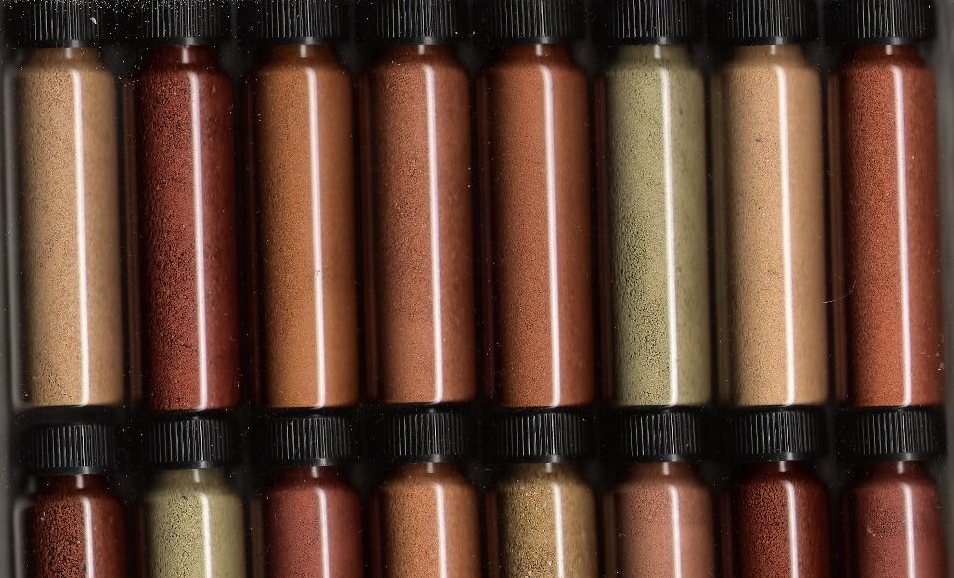
Sand Collecting 101
Admit it, you’re at least mildly curious now. So where does a new sand collector start?
Know the rules: Do your research ahead of time and understand where you are allowed to collect samples. Regulations vary depending on location, and you might have to do some digging (pun intended) to determine if collecting is allowed or seek permission from a landowner.
If you’re collecting overseas and transporting samples across international borders, it’s also worth checking the customs regulations. Sand and rocks are inorganic materials, so theoretically they shouldn’t be a biosecurity hazard. But good luck trying to explain that to a cranky TSA agent… trust me, it doesn’t work. (Most of my own collection is now stored in a closet in my childhood home, as I couldn’t legally import them into Australia.)
Don’t disturb the local ecosystem: Much of this is common sense, but it bears repeating: Only take a small amount of sand — you don’t need a bucket’s worth. Don’t dig large holes, step on plants, dig up animal burrows, or wander off the trail onto fragile soils.
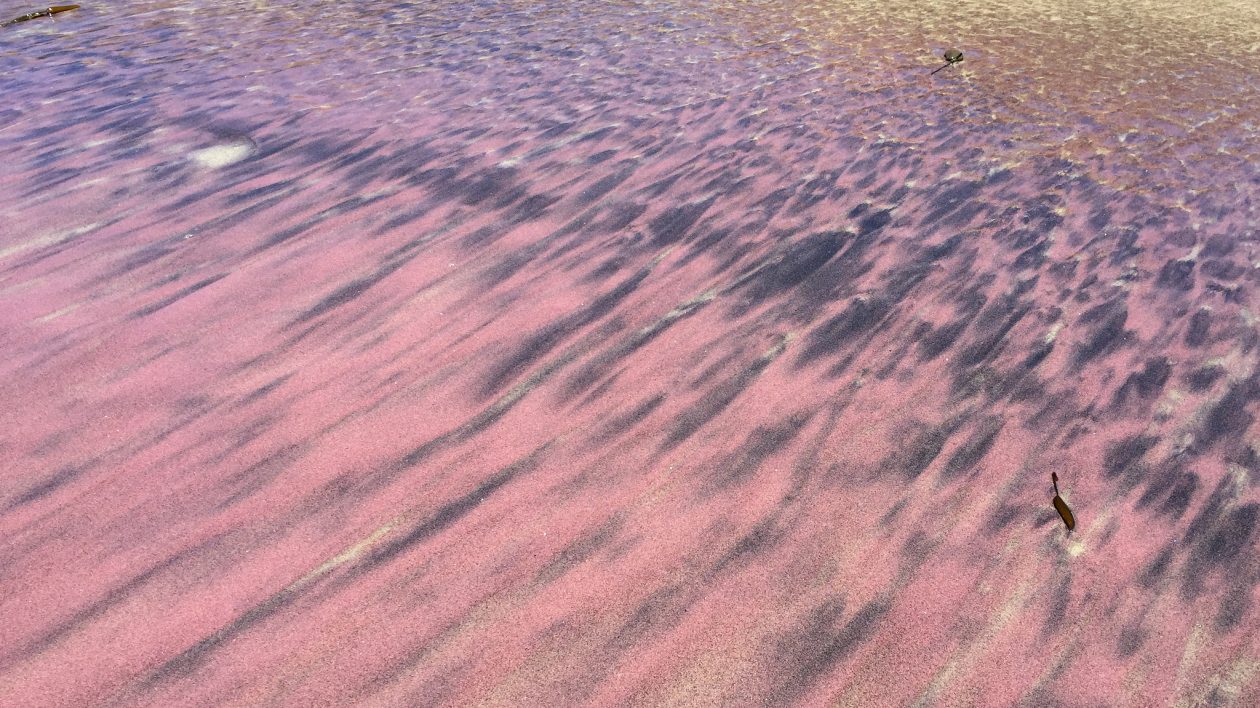
Keep your eyes open: Sands of different textures, colors and composition can often be found quite close to one another. Sometimes it can be hard to see these differences in situ, depending on the lighting. When in doubt, take a sample.
Bring your collecting kit: You don’t need much to collect your own sand samples. I carry a handful of small ziplock bags, each marked with a number (1, 2, 3…). When I collect a sample I jot down the bag number and details about the location in my phone. For those who like a little more specificity, you can record a GPS coordinate instead.
You can also simply mark that information on the bags as you go, but I prefer to rinse and reuse my bags a few times to cut down on my plastic consumption. In a pinch, a waterbottle is always handy, even if it means finishing your hike a bit thirsty.
And if you’re collecting wet sand, take a little bit more than you think you’ll need, as the sand will reduce in volume as it dries.
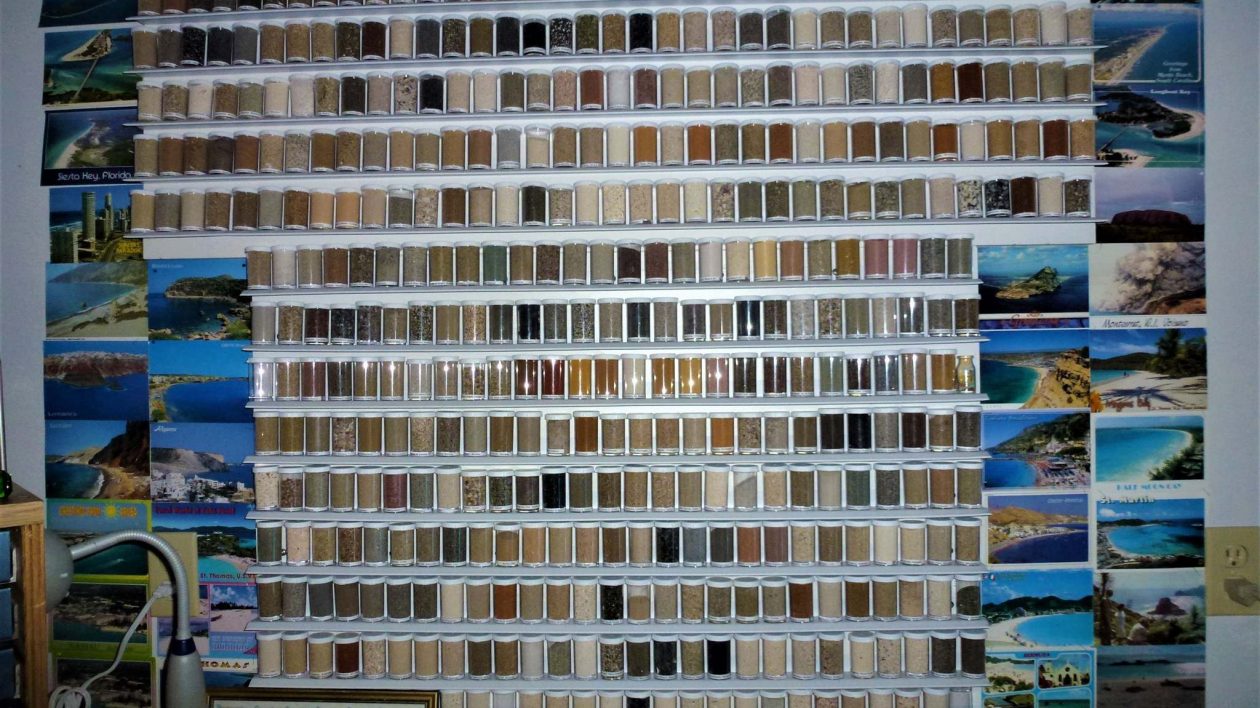
Decide how you will document and display: Options abound when it comes to storing your collection. Some collectors maximize their space by storing samples in identical containers, often with custom storage racks or drawers. (You can find hundreds of options from wholesale container and lab supply stores.) Others opt for a more artistic look, using a variety of glass bottles of different sizes and shapes.
I used to prefer small, glass apothecary bottles sourced from thrift shops and antique markets. But I’m eyeing a to transition to the uniform, bulk-order bottle approach very soon, as my collection grows and becomes more difficult to store and transport during moves.
Whatever containers you choose, make sure your sand is dry before you store it. I dry mine on a cookie sheet in the sun (or the oven) and then filter it through a kitchen sieve to remove any bits of organic material, like, seeds, grass, etc. Then I use a funnel to decant the final sample into a bottle.
Label, label, LABEL: I can’t stress this enough… label your sand! Small craft tags, basic white printer labels, sharpies — use whatever you like, as long as you can keep track of where and when you collected the sand in each bottle. Serious collectors will often photograph and log each sample in a digital database or spreadsheet.
Embrace your inner substrate nerd: And perhaps most important of all — stay curious. Turn the next corner, get your hands dirty, and enjoy an oft-overlooked geological wonder.




Inspiring article! Where can I send my sand samples for a composition analysis? I’m having a hard time finding a lab that provides this service. We need an Arenophile Lab.
Nice job, from a sand collector 🙂
Fascinating insights Justine, thanks for sharing.
And all the while, I thought it was just me, surreptiously secreting sand from my various desert jaunts these past 10+ years, including the Mojave, Sonoran, Syrian and the Sahara.
The thing is, I’m also a birdwatcher, too (since childhood), so I’m starting think these ‘nerdy-geek’ pastimes of ours are somehow mutually-inclusive…..don’t you?
Young lady, I applaud your collection. My wife, before I met here, started a sand/dirt collection over 40 years ago. At this point we have well over 300 specimens from around the globe. Many we have visited and many have been brought back by friends and relatives. We store them in small glass vials that are about pinky sized. We take a hole punch, write the next number on it, and use clear glue to affix it to the bottom of the vial for tracking purposes. The date, location and provider are kept on index cards.
My wife asked that should she pass before me, if I would empty them all on her resting place. I said I would. And here we thought we were the only dirt collecting crazies in the world! Thanks for sharing your story. David OBrien
I’ve been collecting rocks and minerals since I was 14 (now 63). I’ve recently started collecting sand, and have 115 specs up to this point. I’ve got many samples from friends who have been on holidays – it’s like going on a holiday without the expense! I try to keep as many details as possible – and yes, they ARE on an excel spreadsheet as well as notebooks where I can make sketches, paste in maps and photos. It’s part of my never-ending education. I’ve quite been able to work out the name of the hobby; I am an arenophile; but is the hobby called ‘arenophily, ‘sedimentology’ … or what? I’m negotiating with my long-suffering wife as to how best display them in our home. I think it would be great to start a sand-club for Aussies … we have 11,000 beaches … and then there’s rivers, deserts…!
The only time binoculars scream weirdo is when you’re creeping on people. As a science writer, you know… binos and field guides are tools of the environmental science trade. Birding is normal these days and collecting sand just makes you every geologist/coastal professor’s favorite person.
Wonderful article!
And interesting to me because I collect many different things, including minerals and shells. In addition, I volunteer in the Malacology Department at a natural history museum, where my primary job is to examine sand samples under the microscope that other scientists have collected and pick out any shells or other traces of once living organisms for the museum collection. After I’ve finished picking through all of a particular sand sample, I always keep a small portion of the remaining sand for myself in a vial as a sort of “souvenir” of my work.
I’m now thinking that perhaps I should start collecting my own sand samples!
Great article, very interesting and informative. It is a very addictive hobby.